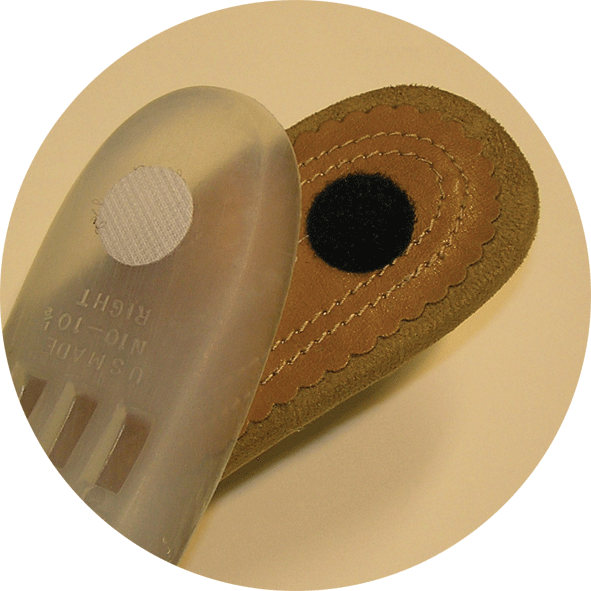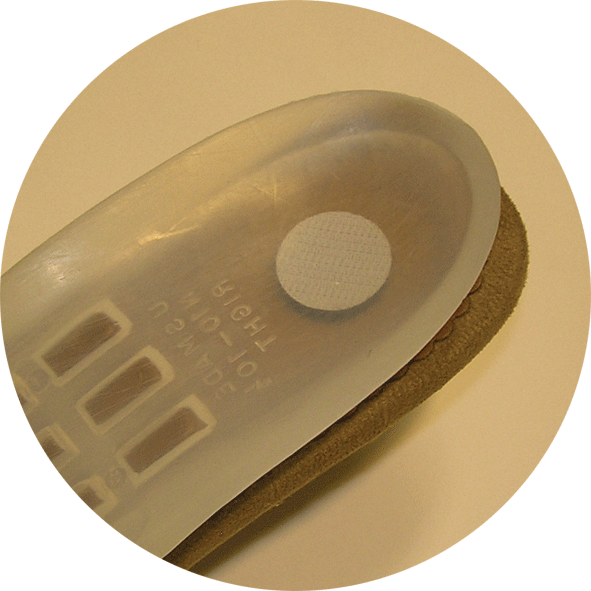Step Flex orthotics will work successfully with a wide range of shoes, including some backless sandals (by using Velcro).
The orthotic cups to the structure of the foot, and will not slide forward in your shoes. With backless shoes we recommend the use of Velcro dots or strips under the heel to prevent the orthotics slipping out backward from under the foot. The pictures below show a wide range of summer sandals that will easily accommodate the orthotics, and will NOT require any use of Velcro.
Our orthotics will not work with jandals (AKA 'flip flops' or 'thongs'). They may be a problem in very tight dress shoes. The heel may slip from the shoe (especially in well-worn shoes, or court shoes). In this case, heel grip (a strip of leather that adheres to the inside of the heel of the shoe) may help. Or add an extra layer of shoe lining under the front of the foot to stop the foot going so far into the shoe. We do not recommend our orthotics for shoes with a heel height greater than 7cm (although many people do exceed this and report good results).
Suitable Styles
 Ideal
Ideal  Could possibly work
Could possibly work  Not recommended
Not recommended
 |
 |
 |
 |
 |
 |
 |
 |
 |
 |
 |
 |
Examples of Suitable Shoes
The orthotics can easily be worn in the following shoes.
 |
 |
 |
 |
 |
 |
 |
 |
 |
 |
 |
 |
 |
 |
 |
 |
 |
 |
 |
Gum Boots
Yes, you can wear Step Flex orthotics in most gum boots. However, gum boots are generally rather loose so the orthotics will slide around with the foot. This is exactly what we want for best function, but the orthotics will wear out much quicker (thin in the heel) when worn this way. We suggest you cut some shoe innersoles to size and place it inside the boots before inserting the orthotics. This will provide a much less abrasive surface to the orthotics. If you work in an environment where dirt or grit gets inside the boots, be sure to clean the inside of your boots regularly. That dirt and grit is like sandpaper!
Backless Sandals
Backless shoes are not as good for your feet as the styles shown on the left, but if you really want to wear our orthotics in backless shoes then this is how:
1. Stand in your sandals with the orthotics in place. The back of the orthotic must cup the back of your heel. Look down and note where the back of the orthotic sits relative to the back of the shoe.
2. Before attaching the velcro dots, clean the underside of the orthotic and the inside of the shoe in that area with methylated spirits and let them dry.
3. Peel off the protective film of the scratchy dot and attach it to the underside of the orthotic in the centre of the heel.
4. Now attach the soft side of the furry dot to the scratchy dot that is already on the orthotic. Peel the protective film from the soft dot.
5. Position the orthotic in the shoe with the heel in the correct spot as noted earlier. Press the orthotic (and hence the velcro dots) firmly against the shoe.
6. Velcro recommend leaving the dots in position overnight to achieve maximum bond before wearing the orthotics.
7. The Velcro may slowly drift out of position over a few days. Then you must remove them, clean the area with methylated spirits and apply new dots.
8. To achieve a stronger bond, purchase a strip of Velcro to give a larger surface area.



